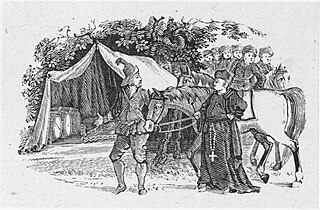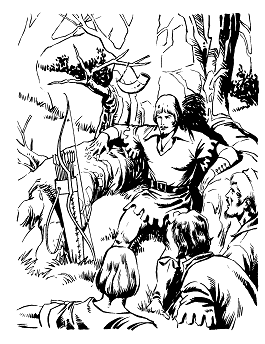This article relies largely or entirely on a single source .(May 2015) |
Robin Hood and the Ranger (Roud 933, Child 131) is an English-language folk song. [1]
This article relies largely or entirely on a single source .(May 2015) |
Robin Hood and the Ranger (Roud 933, Child 131) is an English-language folk song. [1]
Robin Hood, going out to hunt deer, meets a forester who forbids him. They fight. Robin is beaten, and blows his horn, summoning his men. He offers to make him one of their company, and they hold a feast. [2]

Robin Hood is a legendary heroic outlaw originally depicted in English folklore and subsequently featured in literature, theatre, and cinema. He stole from the rich and gave to the poor. According to legend, he was a highly skilled archer and swordsman. In some versions of the legend, he is depicted as being of noble birth, and in modern retellings he is sometimes depicted as having fought in the Crusades before returning to England to find his lands taken by the Sheriff. In the oldest known versions, he is instead a member of the yeoman class. He is traditionally depicted dressed in Lincoln green.
Robin Hood's Chase is an English folk song about Robin Hood, and a sequel to "Robin Hood and Queen Katherine". This song has survived as, among other forms, a late seventeenth-century English broadside ballad. It is one of several ballads about the medieval folk hero that form part of the Child Ballads.
Robin Hood Rescuing Will Stutly is a traditional English-language folk song about Robin Hood.
"Robin Hood's Progress to Nottingham" is an English-language folk song and part of the Robin Hood canon. This song has survived as, among other forms, a late 17th-century English broadside ballad, and is one of several ballads about the medieval folk hero that form part of the Child ballad collection, which is one of the most comprehensive collections of traditional English ballads.
Robin Hood and the Tanner is a late seventeenth-century English broadside ballad and folk song that forms part of the Robin Hood canon.

Robin Hood and the Potter is a 15th century ballad of Robin Hood. While usually classed with other Robin Hood ballads, it does not appear to have originally been intended to be sung, but rather recited by a minstrel, and thus is closer to a poem. It is one of the very oldest pieces of the surviving Robin Hood legend, with perhaps only Robin Hood and the Monk older than it. It inspired a short play intended for use in May Day games, attested to around 1560. It was later published by Francis James Child as Child ballad #121 in his influential collection of popular ballads in the 1880s.
Robin Hood and the Butcher is a story in the Robin Hood canon which has survived as, among other forms, a late seventeenth-century English broadside ballad, and is one of several ballads about the medieval folk hero that form part of the Child ballad collection, which is one of the most comprehensive collections of traditional English ballads. It may have been derived from the similar Robin Hood and the Potter.
"Robin Hood and the Golden Arrow" is an English folk song, part of the Robin Hood canon. It features an archery competition for a golden arrow that has long appeared in Robin Hood tales, but it is the oldest recorded one where Robin's disguise prevents his detection.
Robin Hood and the Valiant Knight is an 18th century ballad of the death of Robin Hood. The song, written in Modern English, was included in the popular "garlands" (collections) of Robin Hood stories and songs published in the 18th and early 19th centuries, generally at the end as a suitable close to the garland. It was later published by Francis James Child as Child ballad #153 in his influential collection of popular ballads.
Robin Hood's Delight is an English folk song. It is a story in the Robin Hood canon which has survived as, among other forms, a late seventeenth-century English broadside ballad, and is one of several ballads about the medieval folk hero that form part of the Child ballad collection, which is one of the most comprehensive collections of traditional English ballads.

The King's Disguise, and Friendship with Robin Hood is an English ballad of Robin Hood. It is a relatively late work in the corpus, found in the Forresters Manuscript from the 1670s. The work seems loosely based on the 7th and 8th fyttes of A Gest of Robyn Hode which recounts the end of Robin Hood's outlawry after an encounter with the king. Unlike Gest, the king is not acting out of the need to suppress Robin; additionally, The King's Disguise and Friendship uses the 17th century updates to the legend that places Robin as contemporaneous with King Richard's reign. In the late 1800s, Francis James Child included it in his influential collection, the Child Ballads, as #151.

A Gest of Robyn Hode is one of the earliest surviving texts of the Robin Hood tales. Written in late Middle English poetic verse, it is an early example of an English language ballad, in which the verses are grouped in quatrains with an ABCB rhyme scheme, also known as ballad stanzas. Gest, which means tale or adventure, is a compilation of various Robin Hood tales, arranged as a sequence of adventures involving the yeoman outlaws Robin Hood and Little John, the poor knight Sir Richard at the Lee, the greedy abbot of St Mary's Abbey, the villainous Sheriff of Nottingham, and King Edward of England. The work survives in printed editions from the early 16th century, just some 30 years after the first printing press was brought to England. Its popularity is proven by the fact that portions of more than ten 16th- and 17th-century printed editions have been preserved. While the oldest surviving copies are from the early 16th century, many scholars believe that based on the style of writing, the work likely dates to the 15th century, perhaps even as early as 1400. The story itself is set somewhere from 1272 to 1483, during the reign of a King Edward; this contrasts with later works, which generally placed Robin Hood earlier in 1189–1216, during the reigns of Richard I of England and John, King of England.
Robin Hood and the Bishop is an English-language folk song describing an adventure of Robin Hood. This song has also survived as a late seventeenth-century English broadside ballad, and is one of several ballads about the medieval folk hero that form part of the Child ballad collection, which is one of the most comprehensive collections of traditional English ballads.
Robin Hood and the Bishop of Hereford is Child ballad 144.
"Robin Hood's Birth, Breeding, Valor, and Marriage" is an English folk song. It recounts Robin Hood's adventures hunting and a romance with Clorinda, the queen of the shepherdesses, a heroine who did not prove able to displace Maid Marian as his sweetheart.
A True Tale of Robin Hood is an English folk song, featuring Robin Hood and, indeed, presents a full account of his life, from before his becoming an outlaw, to his death. It describes him as the Earl of Huntington, which is a fairly late development in the ballads. It definitively places him in Richard the Lionhearted's reign.
Robin Hood and the Shepherd is a story in the Robin Hood canon which has survived as, among other forms, a late seventeenth-century English broadside ballad, and is one (#135) out of several ballads about the medieval folk hero that form part of the Child ballad collection, which is one of the most comprehensive collections of traditional English ballads.
"Robin Hood and the Beggar" is a story in the Robin Hood canon which has survived as, among other forms, a late seventeenth-century English broadside ballad, and is a pair out of several ballads about the medieval folk hero that form part of the Child ballad collection, which is one of the most comprehensive collections of traditional English ballads. These two ballads share the same basic plot device in which the English folk hero Robin Hood meets a beggar.

The Merry Men are the group of outlaws who follow Robin Hood in English literature and folklore. The group appears in the earliest ballads about Robin Hood and remains popular in modern adaptations. History The Merry Men are Robin Hood's group who work to rob from the rich and give to the poor. They have antagonized the tyrannical rule of Prince John while King Richard is fighting in the Crusades. This also puts them into conflict with Prince John's minions, Guy of Gisbourne and the Sheriff of Nottingham.

Robin Hood and Little John is Child ballad 125. It is a story in the Robin Hood canon which has survived as, among other forms, a late seventeenth-century English broadside ballad, and is one of several ballads about the medieval folk hero that form part of the Child ballad collection, which is one of the most comprehensive collections of traditional English ballads.